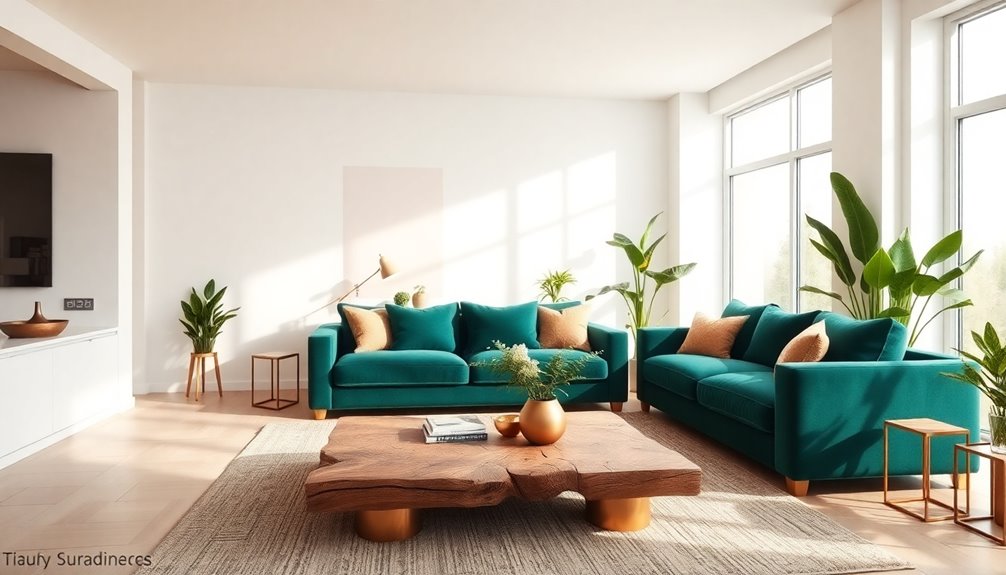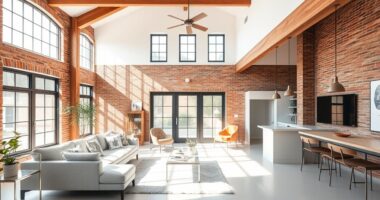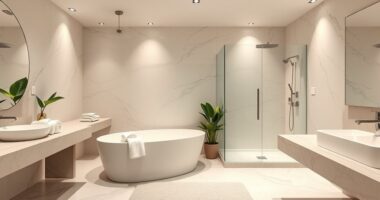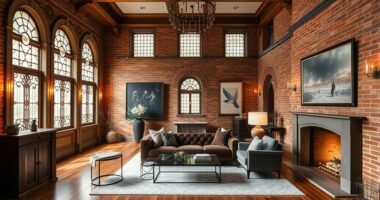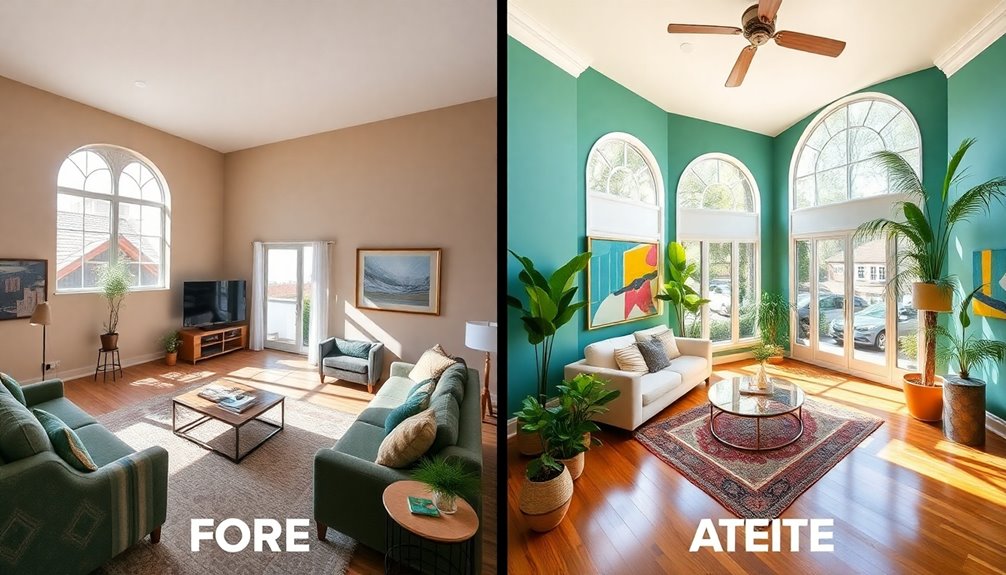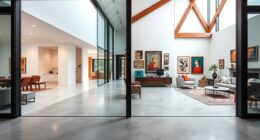To stop living in the past, embrace the top remodel trends of 2025. Shift away from outdated gray tones and all-white interiors, opting for warm color palettes that foster cozy environments. Incorporate natural materials like reclaimed wood and jute, enhancing both aesthetics and sustainability. Kitchen innovations, like two-toned cabinetry, and smart home technology, simplify daily living and boost energy efficiency. Create multi-functional spaces that accommodate modern lifestyles, and invest in outdoor areas that serve as personal retreats. Each of these choices enhances comfort and well-being, leading to a refreshed living experience. Discover even more exciting trends waiting for you! Find remodel inspiration in biophilic design, which brings the natural world indoors through the use of greenery, natural light, and organic shapes. Embrace the trend of maximalism, incorporating bold patterns, rich textures, and luxurious finishes to create visually stunning and dynamic spaces. Take cues from the past while looking towards the future, blending vintage and modern elements to create a timeless and unique aesthetic. With the ever-evolving landscape of design, there is no shortage of remodel inspiration to create the perfect space for your needs and desires.
Key Takeaways
- Embrace warm color palettes like terracotta and deep reds to create inviting and cozy living spaces, moving away from outdated gray tones.
- Prioritize natural materials, such as reclaimed wood and locally sourced stone, to promote sustainability and a connection to nature in your design.
- Integrate smart home technology for enhanced energy efficiency and convenience, utilizing voice-controlled automation and remote monitoring capabilities.
- Optimize living spaces with multi-functional layouts and clever storage solutions, accommodating diverse lifestyles while maintaining style and organization.
- Expand outdoor areas with climate-controlled patios and comfortable furniture, transforming backyards into cozy retreats for relaxation and entertainment.
Outdated Trends to Avoid

When it comes to remodeling your home in 2025, avoiding outdated trends is essential for creating a space that feels fresh and inviting. One of the biggest pitfalls to watch out for is the lingering popularity of gray tones. Homeowners are shifting away from this cold palette, instead opting for warm colors that foster a more inviting atmosphere. Additionally, upgrading to a dual-flush toilet system can enhance water efficiency in your bathroom, aligning with modern sustainability practices.
You'll also want to steer clear of unfinished open shelving. It tends to create visual clutter, so consider closed storage solutions that promote a more organized environment.
All-white interiors are becoming monotonous, making way for layered color schemes that enhance comfort. Incorporating warm color palettes can create a cozy atmosphere that resonates with the current design preferences.
Finally, ultra-modern aesthetics are giving way to cozy, vintage-inspired designs that prioritize comfort over stark minimalism.
Embracing Warm Color Palettes

Transform your space by embracing warm color palettes that breathe life and comfort into your home in 2025. As homeowners increasingly seek cozy environments, shifting from cool, neutral tones to inviting warm colors can greatly enhance your emotional well-being. Decluttering spaces not only allows for a fresh start but also complements the inviting nature of warm hues.
Earthy hues like terracotta, soft yellows, and deep reds create a welcoming atmosphere that promotes relaxation and connection. Additionally, incorporating cozy textiles like blankets and rugs can enhance the warmth of these tones and provide an extra layer of comfort.
Incorporating these warm colors into your design choices can be as simple as repainting walls or integrating warm-toned accents through furniture and decor.
Consider two-toned cabinetry in your kitchen, where warm colors can make a striking statement while maintaining aesthetic appeal. This trend not only elevates the style of your space but also fosters a nurturing environment. Additionally, using natural materials can further enhance the warmth and authenticity of your decor choices.
The Rise of Natural Materials

As you consider your next remodeling project, think about how incorporating natural materials can enhance authenticity in your design.
By choosing sustainable options like reclaimed wood or locally sourced stone, you not only create a unique aesthetic but also contribute to a more eco-friendly home. This shift toward organic materials lets you connect with nature while making responsible choices for the environment. Additionally, embracing self-care practices through your living space can significantly improve your overall well-being and happiness. Incorporating natural elements into your design can create a serene atmosphere that promotes relaxation. To maximize the impact of natural elements, consider integrating features such as vertical storage solutions that celebrate the beauty of these materials while keeping your space organized. Furthermore, the use of natural materials like jute and cotton can add warmth and texture to your bathroom's decor, enhancing its rustic charm.
Authenticity in Design
Authenticity in design means prioritizing natural materials that foster a genuine connection to the environment. As you remodel your space, reflect on how the choice of materials can transform your home into a sanctuary that reflects your values. Commercial grade heat pumps can also enhance the comfort of your remodeled spaces by providing efficient heating and cooling solutions, especially with their lower carbon footprints compared to traditional systems. Additionally, modern heat pumps are designed to operate at quieter noise levels, ensuring a peaceful environment.
The trend favors organic options, steering away from engineered materials and leaning towards those that showcase nature's beauty.
Here are some key elements to reflect on:
- Natural woods, with their visible knots and imperfections, bring warmth and authenticity to your interiors.
- Handmade tiles featuring tonal variations create unique, character-filled spaces, distancing from mass-produced aesthetics.
- Biophilic design principles emphasize integrating nature into your home, enhancing your well-being and connection to the outdoors.
With eco-consciousness at the forefront, sustainable materials like reclaimed wood and biodegradable fixtures are essential. Additionally, incorporating renewable energy solutions such as solar panels can further reinforce your commitment to a sustainable lifestyle.
By choosing these options, you're not only enhancing your living space but also minimizing your environmental footprint. Energy-efficient heat pumps, for example, can decrease energy bills by up to 50% compared to conventional systems.
Authenticity in design is more than a trend; it's a commitment to creating a home that resonates with your values and connects you to the natural world.
Sustainable Material Choices
The push for authenticity in design naturally extends to sustainable material choices, reflecting a deeper commitment to environmental stewardship. You'll find that homeowners are increasingly turning to eco-friendly materials, prioritizing those that are locally sourced and minimize environmental impact. Recycled and reclaimed products are particularly popular, not only reducing waste but also adding unique character to your space. Additionally, using essential oils derived from sustainable sources can enhance the ambiance of your home while maintaining an eco-conscious approach. Regularly inspecting and maintaining safety equipment ensures that your sustainable home remains a safe environment for all occupants. Including materials that are high in dietary fiber can further contribute to a healthier indoor environment by promoting overall wellness.
Biodegradable materials for flooring and fixtures are gaining traction, promoting responsible living and sustainability in design. Certifications focusing on sustainable practices are becoming essential in the remodeling process, indicating a strong expectation for eco-friendly homes by 2025. Additionally, the impact of wood-burning on air quality and health underscores the importance of selecting sustainable materials that contribute to a healthier living environment.
Here's a quick overview of some sustainable material options you might consider:
| Material Type | Benefits | Considerations |
|---|---|---|
| Natural Woods | Authenticity & aesthetics | Requires maintenance |
| Recycled Products | Reduces waste | Availability can vary |
| Biodegradable Fixtures | Eco-friendly & innovative | May have limited options |
Embracing these natural materials not only enhances the beauty of your home but also aligns with a broader commitment to sustainability.
Functional Kitchen Innovations

Increasingly, homeowners are looking to upgrade their kitchens with functional innovations that simplify daily tasks and enhance the cooking experience.
In 2025, you'll find that smart appliances are at the forefront, offering voice-activated systems that make cooking and meal prep a breeze. Customized cabinets are also gaining traction, maximizing your space with features designed for better organization. Additionally, many homeowners are now considering energy-efficient models of appliances, which can significantly reduce overall energy consumption.
Consider these key trends:
- Statement islands: These serve as focal points, often crafted from bold materials, providing both prep surfaces and casual dining areas.
- High-end upgrades: Induction stovetops and built-in ovens are becoming standard, improving functionality while maintaining a sleek aesthetic.
- Sustainable materials: The push for eco-friendly options means you'll see more locally sourced materials that align with responsible living. Additionally, the rise of tiny homes has encouraged a focus on space-efficient designs that can inspire kitchen layouts in larger homes.
Spa-Like Bathroom Designs

Transforming your bathroom into a spa-like retreat can elevate your daily routine and provide a much-needed escape from the chaos of life. The demand for spa-like bathrooms is on the rise, and features like heated floors and freestanding tubs have become essential for creating a luxurious atmosphere. Adding rainfall showerheads and mini-saunas can greatly enhance your bathing experience, promoting wellness and relaxation. Incorporating smart bathroom technologies can further elevate your bathroom experience, making it both luxurious and convenient.
To achieve the perfect spa ambiance, consider incorporating natural materials like stone and wood. These elements create a tranquil environment that mirrors your favorite spa. Additionally, expanding your bathroom space allows for comfortable rest areas, making it a personal sanctuary to combat stress and anxiety.
Here's a quick overview of essential elements for spa-like bathrooms:
| Feature | Benefit |
|---|---|
| Heated Floors | Comfort and warmth |
| Freestanding Tubs | Luxurious soaking experience |
| Rainfall Showerheads | Relaxing shower experience |
| Functional Storage Solutions | Organized and aesthetically pleasing |
Smart Home Technology Integration

As you plan your remodel, consider integrating enhanced home security systems and voice-controlled automation to elevate your living experience.
These technologies not only boost safety but also add convenience to your daily routine. Incorporating the best home security systems ensures that your home is protected with modern features and reliability. Imagine controlling your lights and security with just your voice, making your home smarter and more efficient. Additionally, incorporating systems that offer professional monitoring options can provide peace of mind when you're away from home. Studies show that homes without security systems are 300% more likely to be burglarized, highlighting the importance of incorporating robust security measures. Furthermore, integrating smart WiFi connectivity into your home can enhance the functionality of your devices and improve overall efficiency.
Enhanced Home Security Systems
In today's world of homeownership, integrating smart home technology with enhanced security systems is a game changer. Imagine being able to monitor your property remotely through a smartphone app, receiving real-time alerts, and having peace of mind knowing your home is secure.
Advanced security systems now come with features like:
- Facial recognition cameras that identify familiar faces
- Motion sensors that alert you to any unusual activity
- Smart locks that allow keyless entry
By customizing these smart security systems, you'll adapt them to your unique lifestyle, learning your household's activity patterns. This means fewer false alarms and a more effective security approach. Additionally, utilizing energy-efficient models can significantly reduce your home's overall energy consumption.
Moreover, investing in these energy-efficient upgrades not only boosts your home's safety but also increases its long-term value. Potential buyers are increasingly drawn to homes equipped with modern security systems, making your property more attractive in the market.
With voice-activated controls becoming standard, you can operate your security devices hands-free, ensuring accessibility for all family members. Embrace the future of home security and enjoy the benefits of a safer, smarter home. Furthermore, incorporating data-driven marketing strategies into your renovation projects can help you effectively communicate the value of these upgrades to potential buyers.
Voice-Controlled Home Automation
With the rise of smart home technology, voice-controlled home automation is becoming an essential part of modern living. You can easily manage your home's lighting, temperature, and security with simple voice commands, making everyday tasks more efficient.
This integration of smart technology isn't just a luxury; it's quickly becoming a standard expectation in home remodeling trends.
Imagine adjusting your thermostat without lifting a finger. Smart thermostats learn your family's habits, helping you cut utility costs while maximizing comfort. You'll notice significant energy savings that come from optimizing your home environment.
Moreover, advanced security systems now include voice-activated features, allowing you to monitor your property remotely. When alerts come in, you can respond instantly, giving you peace of mind whether you're home or away.
As you consider updating your space, incorporating voice-controlled systems adds long-term value to your property. Potential buyers increasingly prioritize homes equipped with modern automation systems, making it a savvy investment.
Embracing voice-controlled home automation not only enhances your lifestyle today but also sets your home apart in the competitive real estate market.
Multi-Functional Living Spaces
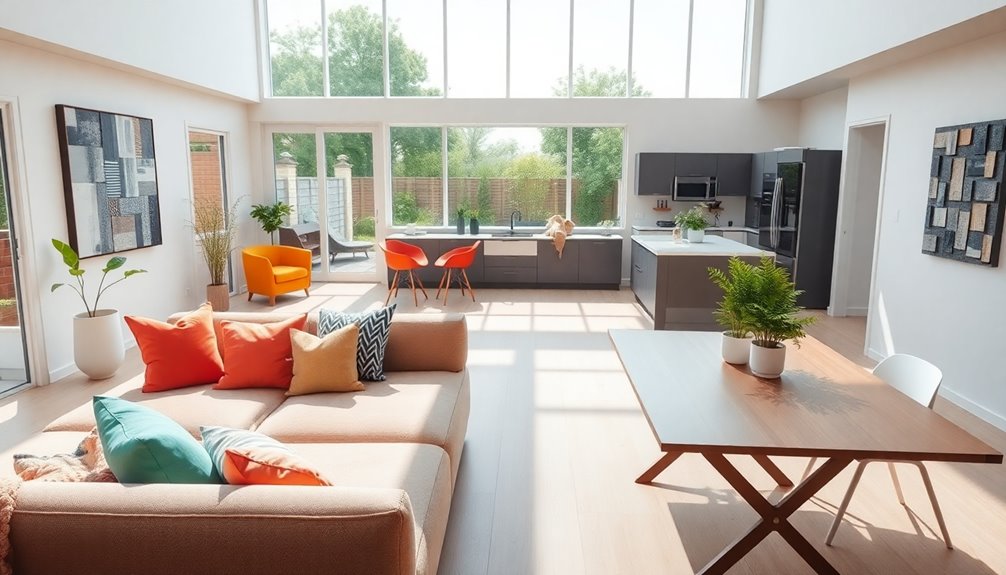
Multi-functional living spaces are evolving how we think about home design, meeting the diverse needs of modern lifestyles. With the rise of remote work and changing family dynamics, you'll find that these adaptable areas can serve multiple purposes, enhancing both flow and functionality in your home.
To make the most of your space, consider these key elements:
- Clever storage solutions: Maximize every inch by incorporating hidden storage options that keep your space organized.
- Modular furniture: Use pieces that can easily shift from one function to another, like a sofa bed or foldable dining table.
- Open floor plans: Foster connectivity by creating expansive areas that allow for seamless movement and abundant natural light.
The concept of a "cloffice," which merges an office space with a closet, exemplifies how practicality can be prioritized without sacrificing style.
Expanding Outdoor Areas

As you rethink your home's layout for modern living, don't overlook the potential of expanding outdoor areas. The demand for outdoor spaces is skyrocketing, especially when it comes to creating functional areas like Outdoor Kitchens. Imagine having built-in grills and pizza ovens, all crafted from weather-resistant materials, right in your backyard.
Expanding outdoor areas allows for seamless connections between your indoor and outdoor environments, enhancing your home's overall livability. Consider adding climate-controlled features such as covered patios, which make your outdoor spaces usable throughout the year, regardless of the weather.
Incorporating fire pits and outdoor bars into your design will elevate both functionality and entertainment potential, making your outdoor spaces perfect for gatherings with friends and family.
Additionally, focus on creating inviting and cozy environments by investing in landscaping and comfortable furniture. Transform your backyard into a personal retreat where you can unwind and enjoy the outdoors.
Sustainable Remodeling Practices

In 2025, embracing sustainable remodeling practices has become essential for homeowners looking to enhance their living spaces while minimizing their environmental impact.
By prioritizing eco-friendly building materials, you not only create a beautiful home but also contribute to a healthier planet.
Here are three key sustainable practices you can adopt:
- Use Recycled and Reclaimed Products: These materials help minimize waste and lower your carbon footprint, making them a smart choice for any renovation.
- Opt for Energy-Efficient Upgrades: Installing energy-efficient appliances, windows, and doors can boost your property value while saving you money on utility bills in the long run.
- Choose Locally Sourced Materials: Supporting regional craftsmanship reduces transportation emissions and strengthens your local economy.
Biodegradable materials are increasingly becoming the standard for flooring and fixtures, reflecting a significant shift toward options that have a lower environmental impact throughout their lifecycle.
Frequently Asked Questions
What Will Be in the Interior Design Forecast for 2025?
In 2025, you'll see a shift towards sustainable and eco-friendly designs in interior spaces.
Expect warm color palettes with earthy tones that create cozy atmospheres.
Smart home technology will enhance your living experience by integrating convenience and energy efficiency.
Open concept layouts will evolve to include multi-functional spaces, blending indoor and outdoor living.
Plus, spa-like bathroom designs featuring luxurious amenities will become a must-have, turning your home into a serene retreat.
Is $100,000 Enough to Renovate a House?
Yes, $100,000 can be enough to renovate a house, but it really depends on what you plan to do.
For mid-range homes, you can cover essential projects like kitchen upgrades and bathroom remodels.
Just keep in mind that costs vary by location and project scope.
It's smart to prioritize your needs and set aside an extra 10-20% for unexpected expenses.
This way, you'll stay within budget while achieving your renovation goals.
What Type of Remodel Adds the Most Value?
Imagine walking into a stunning kitchen where natural light dances off sleek countertops and modern appliances hum with efficiency.
If you're looking to add the most value to your home, focus on kitchen remodels. They often yield over 70% of your investment back, making them a smart choice.
Following closely are bathroom renovations with spa-like features, and don't overlook enhancing outdoor spaces; these also deliver impressive returns when done right.
Are Home Renovations Declining?
You might think home renovations are declining, but the reality is a shift in focus. Homeowners are prioritizing smaller, targeted upgrades that boost energy efficiency and comfort rather than undertaking extensive remodels.
Economic uncertainty and rising housing costs are making people reconsider major projects. However, the demand for multi-functional spaces and smart technology shows that interest in renovations is evolving, not disappearing.
